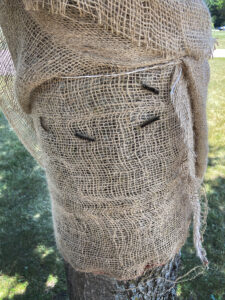By Bill McNee, DNR Forest Health Specialist, Oshkosh
bill.mcnee@wisconsin.gov or 920-360-0942

Spongy moth caterpillars clustered below a sticky barrier. Photo: Mark Guthmiller, Wisconsin DNR
This June and July, spongy moth populations are predicted to reach damaging levels in parts of Wisconsin. Populations began to rise in 2020, and this is likely to be the third year of the pest outbreak in some regions of southern Wisconsin.
At present, damaging populations are expected to be most noticeable in southern counties, counties to the north of the city of Green Bay, and in far northern Wisconsin near Lake Superior. Additional areas are likely to have high populations that are more concentrated in size.
High numbers of spongy moth caterpillars are a tremendous nuisance and can strip trees of their leaves. This may kill the tree when it occurs in combination with other stresses such as drought or root damage. The insect’s favorite food is oak leaves, but it will feed on many other tree species such as aspen, birch, crabapple and willow.
Several methods can be used to take action to reduce the number of caterpillars that will feed on high-value trees.
Sticky Barrier Bands
These bands will prevent crawling caterpillars from climbing into your trees. At a convenient height, wrap a belt of duct tape 4-6 inches wide around each tree trunk, shiny side out and with the tape pressed into bark crevices. Smear the center of the band with a sticky, horticultural pest barrier available at garden centers, hardware stores and many other retailers.
Caterpillars below the duct tape can be brushed into a can of soapy water to drown them. It is easy to replace the barrier if it becomes dirty or coated with caterpillars. This band can be removed when a burlap collection band is placed on the tree.
Burlap Collection Bands

Spongy moth caterpillars on a burlap band. Photo: Bill McNee, Wisconsin DNR
When spongy moth caterpillars are about one inch long, many will begin a daily migration down the tree to hide from predators. You can take advantage of this behavior by creating a band of burlap that the caterpillars can hide under, so that you can destroy them.
When the caterpillars reach this size, cut a piece of burlap 12 to 24 inches wide and long enough to completely wrap around the tree at chest height. Tie a piece of string around the middle of the burlap and fold the upper portion down to form a “skirt” around the tree. Every afternoon, check under the burlap and brush the caterpillars into a bucket of soapy water to kill them. The burlap bands can be removed in July or August, once the caterpillars are no longer seen.
Insecticide Options
When very large numbers of caterpillars are present, you may choose to spray trees with an insecticide before the caterpillars can become a nuisance or eat the tree’s leaves. Bacterial insecticides must be applied while the caterpillars are smaller than one-half inch long. Chemical insecticides may be applied while caterpillars are present.
Insecticides may be applied as a cover spray, soil drench, soil injection or trunk injection. Follow the instructions on the insecticide container.
If you choose to hire a pesticide applicator, arrange for insecticide treatments ahead of time to avoid a last-minute rush when pesticide application businesses may already be very busy. Resources for finding a qualified pesticide applicator include the Wisconsin Arborist Association, International Society of Arboriculture, other websites and your local phone book.
Planning For A 2024 Aerial Spray
If large numbers of caterpillars are seen over a bigger area of high-value trees (residential area, campground, park, etc.), an aerial spray may be a suitable option in 2024. Planning can be time-consuming and complicated, and it is suggested that organizers start planning as early as this summer for a 2024 aerial spray. You can find a Wisconsin Department of Natural Resources guide to help organize an aerial spray here.
During the growing season, we suggest property owners water ornamental trees in weeks when there is no significant rainfall. This will help to reduce tree stress and aid a tree’s recovery from heavy defoliation should it occur.
Additional information on spongy moth management is available by visiting the Wisconsin Spongy Moth Portal. Homeowners seeking assistance can also call the DNR spongy moth information line at 1-800-642-6684 (MOTH).
